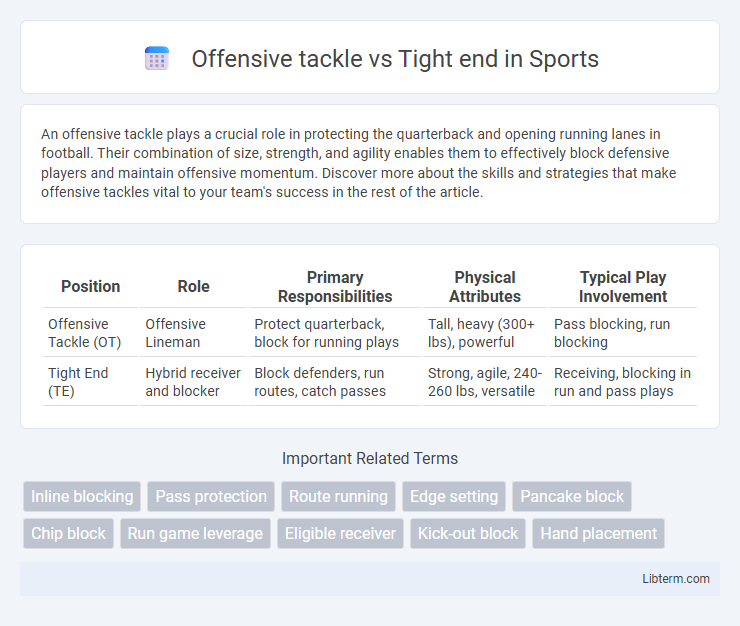An offensive tackle plays a crucial role in protecting the quarterback and opening running lanes in football. Their combination of size, strength, and agility enables them to effectively block defensive players and maintain offensive momentum. Discover more about the skills and strategies that make offensive tackles vital to your team's success in the rest of the article.
Table of Comparison
| Position | Role | Primary Responsibilities | Physical Attributes | Typical Play Involvement |
|---|---|---|---|---|
| Offensive Tackle (OT) | Offensive Lineman | Protect quarterback, block for running plays | Tall, heavy (300+ lbs), powerful | Pass blocking, run blocking |
| Tight End (TE) | Hybrid receiver and blocker | Block defenders, run routes, catch passes | Strong, agile, 240-260 lbs, versatile | Receiving, blocking in run and pass plays |
Offensive Tackle vs Tight End: Key Differences
Offensive tackles primarily focus on protecting the quarterback and creating running lanes, using their size and strength to block defensive players on the line of scrimmage. Tight ends serve a dual role, combining offensive lineman blocking responsibilities with pass-catching duties, making them versatile weapons in both the running and passing game. The key difference lies in offensive tackles being specialized blockers with minimal receiving roles, while tight ends balance blocking with receiving, often lining up on the edge of the offensive line.
Primary Roles and Responsibilities
The offensive tackle is primarily responsible for protecting the quarterback from edge rushers and creating running lanes by blocking defensive ends and linebackers. Tight ends serve a dual role, acting as both blockers on the offensive line and receivers, requiring versatility to catch passes and block in both running and passing plays. While offensive tackles focus mainly on pass protection and run blocking, tight ends balance receiving routes with key blocking assignments depending on the offensive scheme.
Physical Attributes and Skill Set Comparison
Offensive tackles require exceptional size, strength, and quick footwork to effectively protect the quarterback and create running lanes, typically standing 6'5" to 6'8" and weighing 300-330 pounds. Tight ends combine muscular build and agility, often measuring 6'3" to 6'6" and weighing 240-260 pounds, balancing blocking capabilities with route-running and catching skills. While offensive tackles focus on isolating defenders with powerful hand techniques and lateral mobility, tight ends must excel in versatility, blending blocking proficiency with reliable hands and spatial awareness in the passing game.
Blocking Techniques: Tackle vs Tight End
Offensive tackles employ powerful pass-blocking techniques, utilizing wide sets and quick lateral movements to protect the quarterback from edge rushers, relying on strength to anchor against bull rushes. Tight ends combine blocking agility and versatility, executing both inline blocking and downfield blocks, often mixing power blocking with route running to create mismatches against linebackers or safeties. While tackles primarily focus on run and pass protection in the trenches, tight ends balance blocking responsibilities with receiving duties, making their blocking more situational and dynamic.
Receiving Abilities and Pass Catching
Offensive tackles primarily focus on blocking and rarely participate in receiving plays, making them less proficient in pass catching compared to tight ends. Tight ends possess versatile skill sets, combining blocking with strong route running and reliable hands, enabling them to serve as key receivers in both short and intermediate passing games. Their receiving abilities are crucial for creating mismatches against linebackers and defensive backs, enhancing offensive versatility and passing efficiency.
Alignment and Position on the Field
Offensive tackles line up at the outer edges of the offensive line, directly next to the guards, primarily responsible for protecting the quarterback and opening running lanes. Tight ends position themselves on either end of the offensive line but tend to align slightly outside the tackles, serving dual roles as blockers and receivers. The tackle's alignment closer to the line's core focuses on blocking, while the tight end's more versatile positioning facilitates both pass-catching and run support.
Impact on Offensive Schemes
Offensive tackles primarily anchor the offensive line, creating essential protection for the quarterback and clearing running lanes, which stabilizes the pocket and enhances rushing efficiency. Tight ends provide versatile roles, serving as both blockers in the run game and reliable receivers in passing schemes, allowing offenses to diversify play-calling and exploit mismatches. The interplay between these positions directly shapes offensive schemes by balancing pass protection with route running, ultimately influencing play design complexity and success rate.
Notable Offensive Tackles and Tight Ends in NFL History
Notable offensive tackles such as Anthony Munoz and Jonathan Ogden revolutionized NFL offensive lines with their exceptional pass-blocking and run-blocking skills, protecting quarterbacks and creating openings for running backs. Renowned tight ends like Tony Gonzalez and Rob Gronkowski redefined the position with their exceptional receiving abilities combined with blocking prowess, significantly impacting team offenses. The evolution of these positions highlights the versatility and athleticism required to excel as offensive tackles and tight ends in modern football.
Training and Development Pathways
Offensive tackles prioritize strength training and agility drills to enhance pass protection and run-blocking skills, emphasizing footwork, hand placement, and explosive power development. Tight ends combine size and speed training with route running, catching, and blocking techniques, integrating skill development for both receiving and blocking responsibilities. Both positions benefit from specialized coaching, film study, and progressive conditioning programs tailored to their distinct on-field roles and physical demands.
Choosing Between Offensive Tackle and Tight End
Choosing between offensive tackle and tight end depends on a player's physical attributes and skill set; offensive tackles require exceptional size, strength, and agility to protect the quarterback and create running lanes, while tight ends need a blend of blocking ability and pass-catching skills. Offensive tackles typically excel in pass protection and run blocking in the offensive line, whereas tight ends contribute to both the offensive line and receiving corps, often lining up on the edge. Teams prioritize offensive tackles for interior line stability and tight ends for versatility in both blocking schemes and intermediate passing routes.
Offensive tackle Infographic

 libterm.com
libterm.com